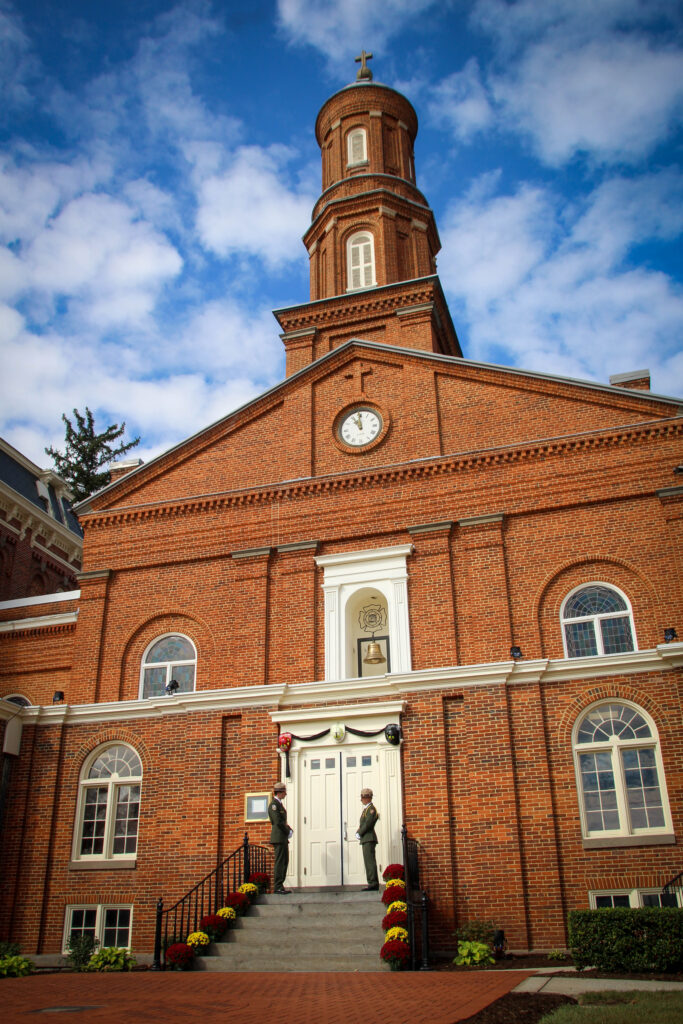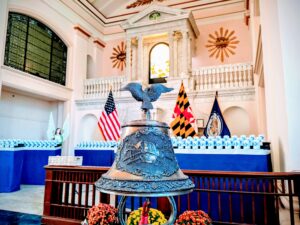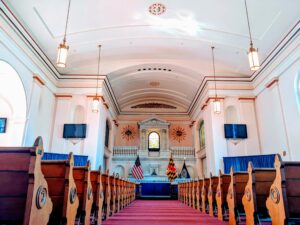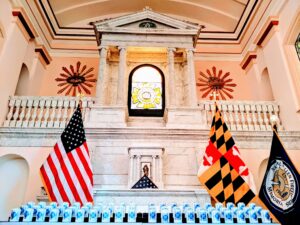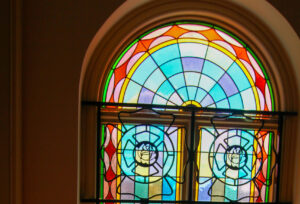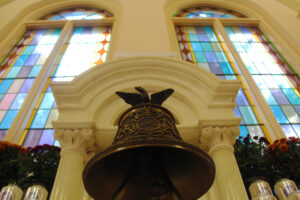Visitors to the Memorial Park will want to spend time in the beautiful and historic Memorial Chapel.
The Chapel and many other buildings on campus are listed on the National Register of Historic Places. In 1997, the site was designated as the National Fallen Firefighters Memorial Chapel to denote its special bond to America’s fallen firefighters and their families.
The Foundation formally dedicated the National Fallen Firefighters Memorial Chapel to the memory of Chief A. Marvin Gibbons of Maryland in 1998. This tribute reflects the many contributions Chief Gibbons made to the establishment of the annual Memorial Service and the National Fallen Firefighters Monument.
During past Memorial Weekends, families of fallen firefighters attended a private service in the Chapel. Rich in fire service tradition, the service included the reading of each fallen firefighter’s name and the ringing of a fire bell.
In 2003, a new tradition began during the Memorial Weekend. On Family Day, the Chapel is open to the families as a place of reflection. While Honor Guard members maintain a silent vigil, families and friends of the fallen heroes can light candles in remembrance of their loved ones and leave a rose in a Maltese Cross vase in the altar area.
History of the Memorial Chapel
During the early 1800s, Mother Elizabeth Ann Seton, the first canonized American-born saint, established the Daughters of Charity in Emmitsburg. In 1809, she opened a boarding school for girls on this site. The school later became St. Joseph’s College, one of America’s first Catholic women’s colleges. The Daughters of Charity closed the College in 1973, and sold the buildings and more than 100 acres to the Federal Government in 1979.
Mother Seton selected the site for the Chapel before her death in 1821. Construction of the Romanesque Revival-style chapel began in 1839. The exterior is brick set on a stone foundation. Tuscan pilasters with granite capitals and bases, semi-circular stained glass windows, brick dentils, and a wood niche grace the outside of the building. A low, turned rail separates the nave from the sanctuary with its marble altar and massive pedimented niche. The bell that hangs in the steeple came from Spain in 1841.
During the Civil War, the Daughters of Charity went to the nearby Gettysburg battlefield and set up headquarters in the McClellan Hotel. From this base, they went out to several sites to nurse the wounded. Both Union and Confederate troops were on the Emmitsburg campus prior to the end of June 1863. After the Battle of Gettysburg, Confederate soldiers passing by the campus in escape were fed.
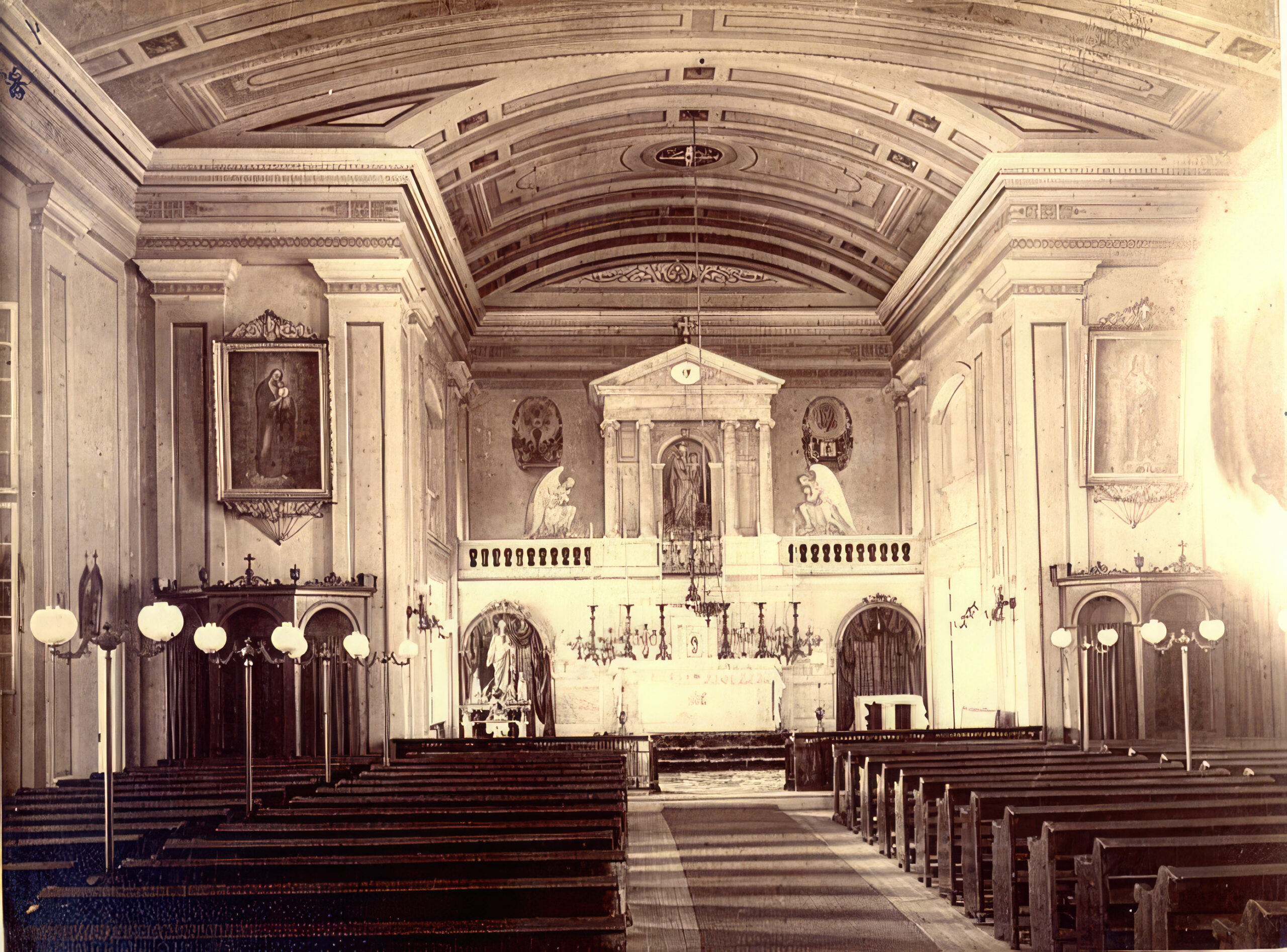
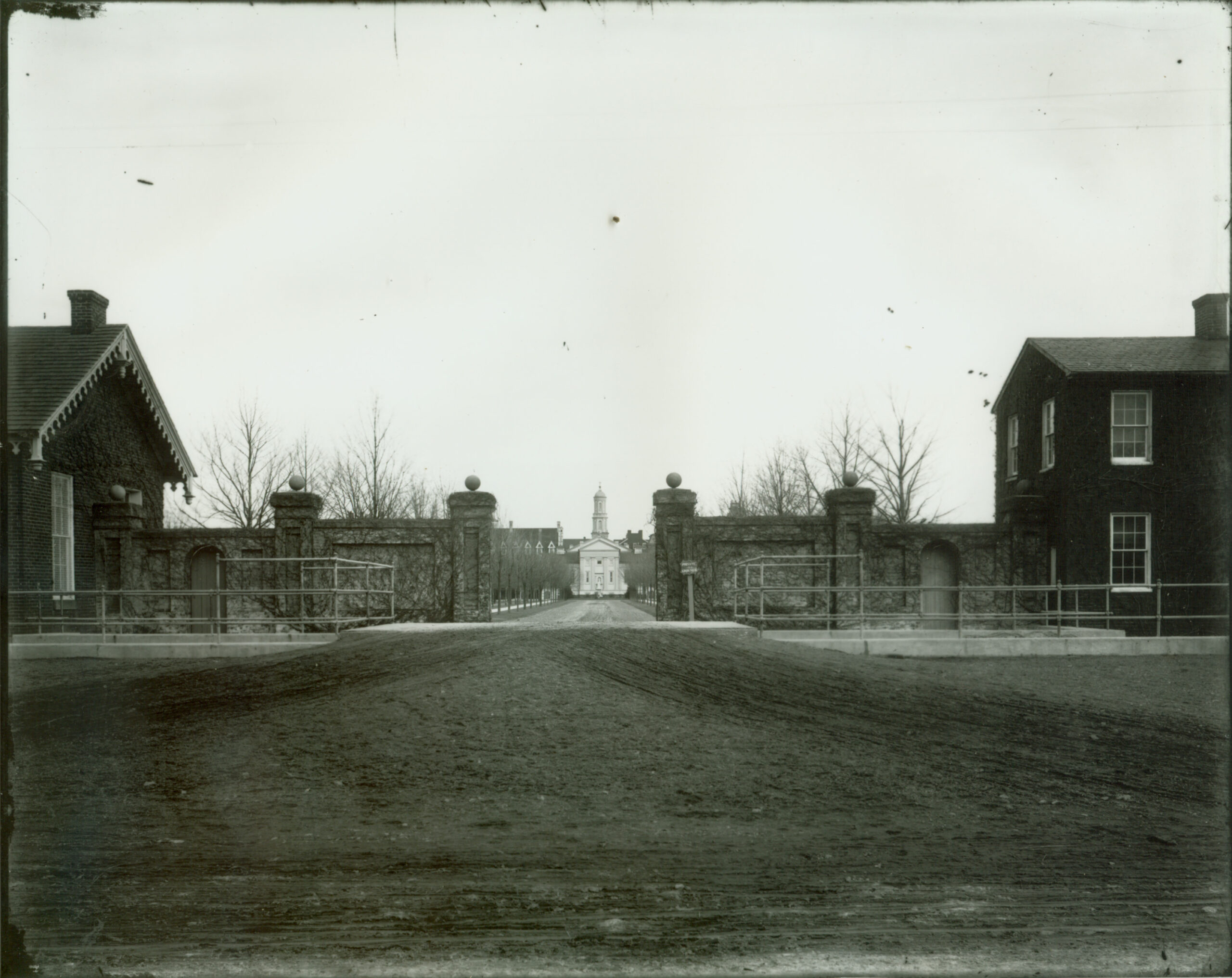

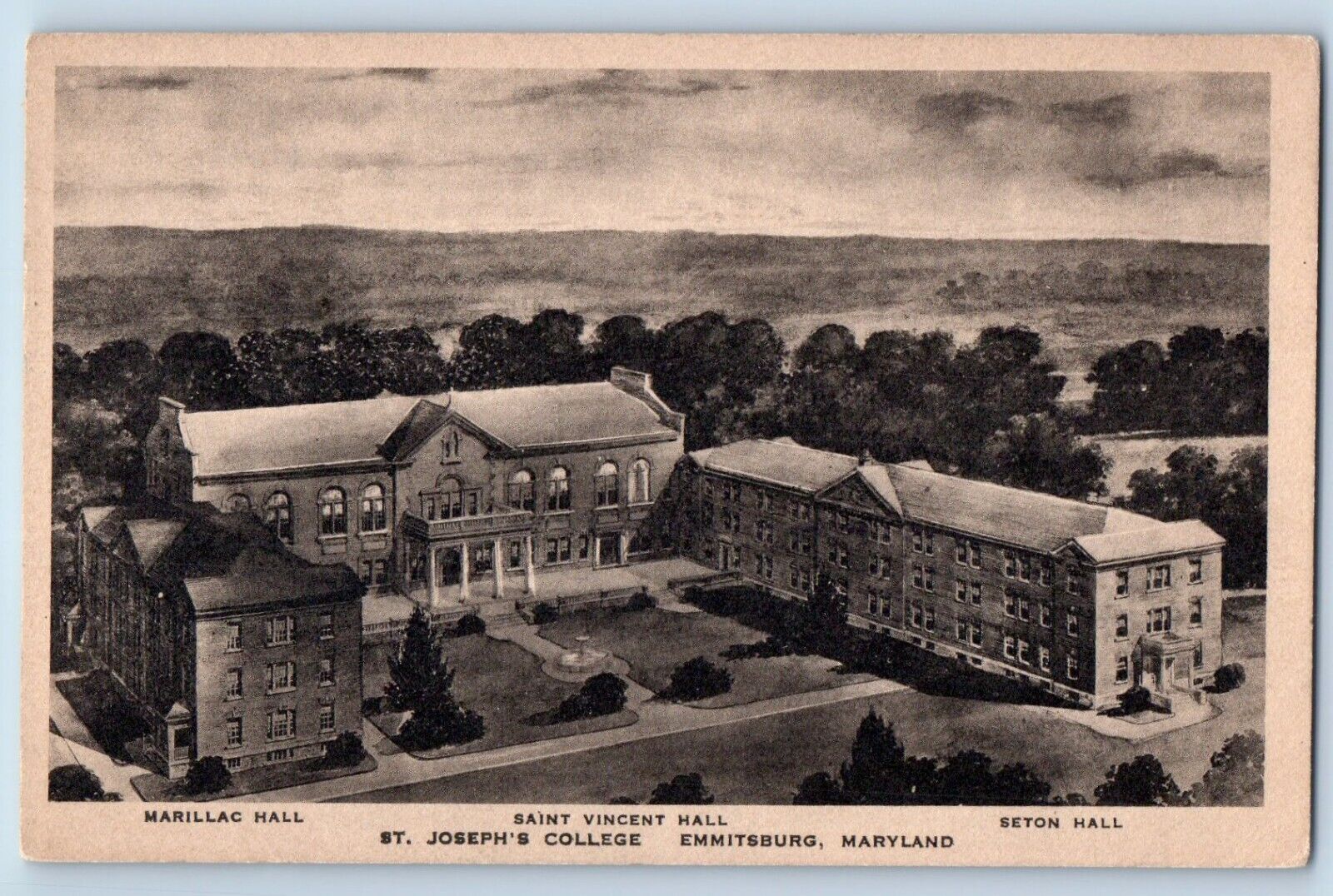
Ground breaking
Placed on the National Historic Register of Historic Places as Saint Joseph College and Mother Seton Shrines
Designated as the National Fallen Firefighters Memorial Chapel and dedicated to the memory of Chief A. Marvin Gibbons
Laying of cornerstone
St. Joseph College Central House sold to the U.S. Government for the National Fire Academy and FEMA
Interior restored by the National Fallen Firefighters Foundation
Dedication of the Memorial Chapel - The Legacy of Chief A. Marvin Gibbons
For over 42 years, Marvin Gibbons made significant and lasting contributions to the fire service at the local, county, state and national levels.
Gibbons served as Fire Chief of the Hillandale Volunteer Fire Company in Montgomery County, Maryland, for 16 years, and as its President for four terms.
He worked to establish an Executive Committee of the Montgomery County Fire Board to develop policy for fire and rescue services. Recognizing that Montgomery County lacked adequate mutual aid agreements, Gibbons helped create the agreements that now exist among Washington, DC metropolitan jurisdictions. While Chairman of the Fire Board, he helped establish the Heart Mobile, the forerunner of the current paramedic program, and was involved with the building of the Public Service Training Academy. Following Gibbons’s death in 1990, Montgomery County dedicated the Fire and Rescue Service Wing of the Training Academy in his memory.
Gibbons served as President of the Maryland State Firemen’s Association (MSFA) and was elected to the MSFA Hall of Fame. He served as both Chairman and Vice Chairman of the MSFA Convention Committee and was a member of the Maryland State Fire Chiefs’ Association.
Gibbons organized efforts to establish a National Fallen Firefighters Memorial on the National Fire Academy campus in Emmitsburg, Maryland. His hard work culminated in the construction of a national monument and the establishment of the annual National Memorial Service, first held in 1982. Today, the National Memorial Service draws thousands of families, firefighters, and officials to the tribute held each October in conjunction with National Fire Prevention Week.
None of this would have been possible without the vision and dedication of Chief A. Marvin Gibbons, who took a dream and turned it into reality. The National Fallen Firefighters Memorial Chapel on the Emmitsburg campus is dedicated to his memory. Future generations will recognize Chief A. Marvin Gibbons as the person who made the national remembrances possible.
Chronological and Architectural Perspectives
Compiled by Sister Betty Ann McNeil, Provincial Archivist, Daughters of Charity
The chapel was built on site chosen by Mother Seton and in Tuscan style which she liked from her time in Livorno, Italy.
Ground breaking to begin construction on site chosen by Mother Seton and in conformity with her recommendation for Tuscan style architecture like she encountered in Tuscany when she was in Livorno and Pisa in 1803-04. The plan was drawn by Rev. W. [Thomas] Butler who offered to superintend the construction along with Sister Margaret Cecilia George, SC, then treasurer at the time. Rev. Butler was reimbursed $100 for his services. Rev. Thomas Butler, who had been at Mount Saint Mary's since 1821 and was then president (1834-1838) of Mount Saint Mary's. His sister, Mary Ann, had been one of the earliest Sisters of Charity.
Butler purchased the bell for the steeple of the church in Baltimore from many that were brought from Spain during the ascendancy of Espartero. After he made his selection, he examined its inscription which indicated it had been cast in 1809, the same year as the establishment of the Sisters of Charity in Saint Joseph's Valley near Emmitsburg. Furthermore the inscription revealed that the bell itself had been dedicated in honor of Saint Joseph, for whom the chapel was named.
Laying of the Cornerstone
Recommendation of expanding size of gallery in choir loft to accommodate both organ and choir comfortably. Consecration of the newly erected Chapel of the Sisters of Charity of Saint Joseph's which also included a crypt chapel (later called Holy Agony Chapel). The main altar of pure marble is the gift of Emily Harper, a former pupil of Mother Seton and granddaughter of Charles Carroll of Carrollton.
At the time of the consecration of the Chapel, “The White House stood a little distance from the Church, but not far. There was a brick pavement that led all around the Church, and between the Church and the White House it was narrow, allowing space enough for one or two, or perhaps three people to walk abreast [about 8-10 feet by another account]. When the Church was consecrated, the procession went around the Church. Upstairs there was a way to enter the Church [from the White House]; the window was cut down to make a door, yet not all the way, for fear of weakening the house; so you had to go up few steps, two or three, and pass over on a narrow railway to get into the Church.” (Sister Helena Elder)
Installation of large clock imported from Paris into bell tower of Church. It was refurbished in 1919 and completely replaced with automated chimes in 1950.
Interior artistic redecoration, including new Stations of the Cross imported from France by Rev. Francis Burlando, CM, Director.
Addition of an extension on the south-side enlarged the Chapel named for Saint John Gabriel Perboyre (1802-1840), a Vincentian martyr whose cause for canonization was then in process.
Installation of marble side altars and renovation of the Perboyre extension. The main Chapel was frescoed, refloored; new lighting fixtures, pews, and windows were installed.
A new organ, the gift of the Parrott family of San Mateo, California, was installed in the Chapel. Mrs. John Parrott, Sr. (née Abigail Meagher of Mobile, valedictorian, SJA, 1848), was a most loyal alumna, sending her daughters the long transcontinental distance to attend her loved Alma Mater, and the family wished to enhance the Academy Chapel.
The Chapel was redecorated (repainting and refrescoing) in preparation for the centennial of the foundation at Emmitsburg. Stained glass windows by Herman Schladermundt were installed at the upper level on each side of the sanctuary. Schladermundt also did stained glass windows of note in the U.S. Library of Congress.
A notable change in the Chapel area was the installation of an electric motor, replacing water power for the organ.
During the summer of 1938, the Holy Agony Chapel, crypt beneath the main Central House Chapel, was renovated. A concrete floor replaced the venerable wooden one, walls were tinted ivory, and the quaint
Stations were carefully restored. Improved lighting threw into relief the Holy Agony group, silhouetted against an artistic representation of the Holy City of Jerusalem.
Marble statues of St. Louise de Marillac and Blessed Catherine Labouré arrived from Italy and were placed on side altars of the Chapel. (These statues have been erected on the grounds of Saint Joseph's Provincial House.)
Chapel enlargement and renovation. Extensive renovation of the Chapel early in the year. The basic paint tone was Caen stone, relieved by motifs in blue and gold. Vastly improved lights were installed, and rubber cushions covered the kneeling benches. The doors located at either side of the sanctuary were obliterated; a new statue of St. Vincent appeared in the niche which he had exchanged with St. Joseph. The sanctuary floor was laid in white marble, as were the altar steps. The border was in green serpentine. New thermo-plastic tile covered the Chapel floor and entrance corridor.
Early in 1950, the French clock whose voice, eight times each hour, had broken the stillness of the Valley ever since 1866, was replaced by an electric clock which chimes four times hourly. By August 24, marble statues of the Sacred Heart, on the Gospel side (left), and of St. Joseph, on the Epistle side (right), had been placed in the Chapel.
Renovations completed in the crypt, Holy Agony Chapel. Considerable renovation took place elsewhere, particularly in the area surrounding the Chapel and Community Room at the Central House. Walls were resurfaced or painted in soft tones, and tile flooring was eventually laid.
Enthronement of Seton reliquary in a copper casket in a marble niche over the main altar in the Chapel of Saint Joseph's Central House following beatification of Elizabeth Ann Seton on March 17.
Translation of Elizabeth Ann Seton’s relics from chapel of Saint Joseph College to the chapel of Saint Joseph’s Provincial House.
Placed on the National Historic Register of Historic Places as Saint Joseph College and Mother Seton Shrines.
Included in the 107 acres and buildings of the former St. Joseph College and St. Joseph’s Central House which the Daughters of Charity sold to the U.S. Government for the National Fire Academy and Federal Emergency Management Agency.
Designated as the National Fallen Firefighters' Memorial Chapel and dedicated to the memory of Chief A. Marvin Gibbons, Past President of Maryland State Firemen's Association.
Restored with interior renovations by the National Fallen Firefighters Memorial Foundation.

